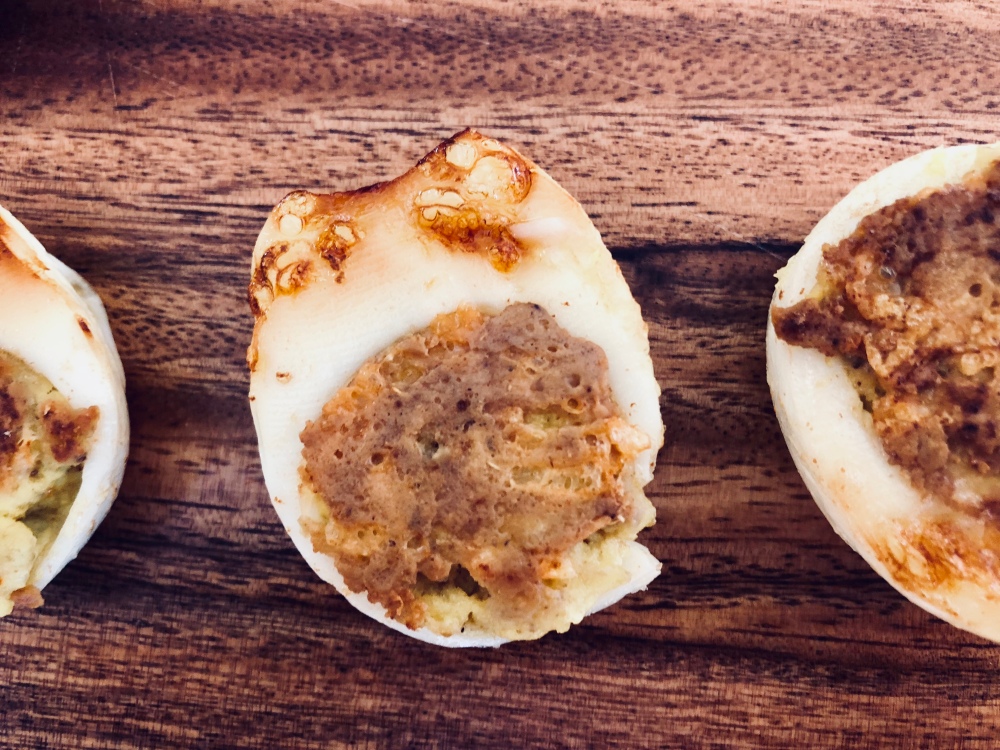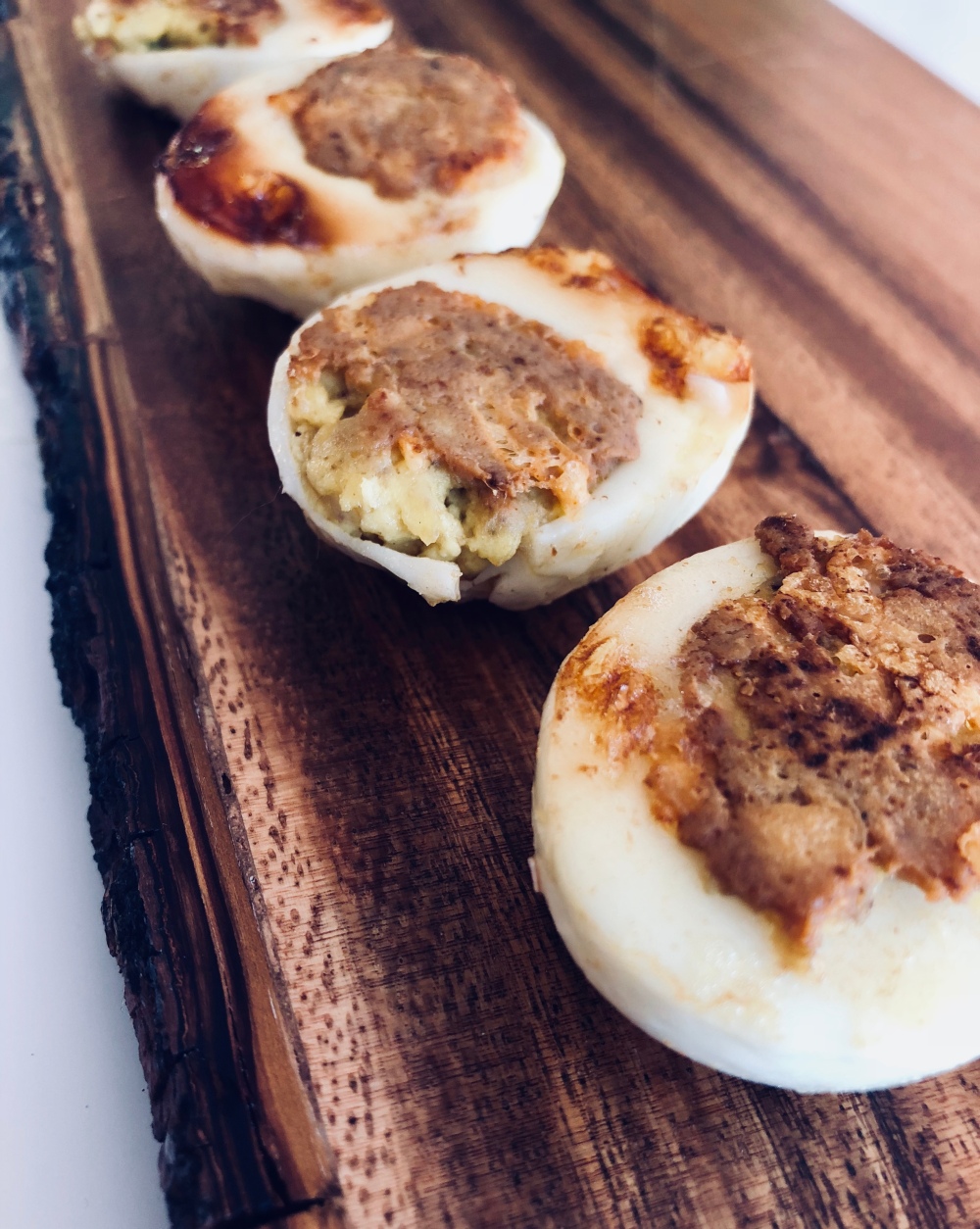This may or may not come as a surprise, but stuffed eggs are far from a modern invention. Stuffed eggs were a popular appetizer in ancient Rome and there are a number of surviving recipes from the Middle Ages. I currently know of 8 distinct medieval variations and I am sure there are plenty more. The recipes vary quite a bit in flavor despite the directions being basically the same. One is baked, but most are fried and some include a special sauce or garnish. One Andalusian (Spanish) recipe doesn’t cook them at all, much like the classic “deviled” eggs we are most familiar with today.
Stuffed eggs were generally called just that, but there is an old Dutch/Flemish one called Split Nuns. The deviled title wasn’t adopted until much later, probably into the mid-18th century to describe the spicy additions like pepper and mustard. Mayonnaise wasn’t added until the end of the 19th.
The Italian recipe below is a pretty standard one, with a suggested garnish in place of a sauce. It comes from an unattributed manuscript containing Latin recipes called Liber de Coquina, which is dated around 1300.
The Recipe

Section III. 12. — De ouis, primo de implendis : ad faciendum oua plena, findas unumquodque per medium, dum fuerint bene cocta et hoc integra. Tunc extrahe rubedinem et, acceptis maiorana, safrano, gariofilis, distempera cum rubedine predictorum ouorum; et pista fortiter, adiuncto parum de caseo. Per singula octo oua, distempera unum ouum crudum. Hoc facto, de isto sapore imple albedines ouorum. Et frige cum bono lardo; et cum agresta comede.
The following English translation is a combination of my own interpretation of the Latin and another unattributed translation that I found online. The original text uses a couple words for redness (rubedine and rubidenum) where the word for yolk should be and I’ll be honest that I don’t know enough about Latin to know the reason why that is. Until then, we’ll go with yolks because, based on context, it’s obvious that is what the recipe is talking about.
Eggs, to prepare for stuffing. To make stuffed eggs, cut through the middle of each one while they are well cooked. Then take out the yolk and upon receiving the marjoram, saffron, and gariofilis (cloves) mix with the aforesaid yolks; and mash it thoroughly, adding a little bit of cheese. For each eight eggs, add one raw egg. This done, fill the egg whites with this mixture. And fry in good lard, and eat with verjuice.
The Ingredients
- 6-8 eggs, hard cooked
- 1/2 tsp. marjoram
- 1/2 tsp. salt
- Pinch or two of cloves
- 1/4 c. grated parmesan or mozzarella cheese
- 3-4 crushed strands of saffron or pinch powdered
- 1 additional egg- whites only
- Butter for frying
- Verjuice or lemon juice to garnish (optional)
Step ONE: Boil the Eggs
If you haven’t boiled eggs before you can try my favorite fail-proof method: Cover the eggs completely with COLD water and bring to a boil. Let it cook at a rolling boil for about a minute – any longer might crack the eggs – then cover the pot and remove from heat. Let the eggs sit in the hot water for about 20 minutes. Remove the eggs and rinse in cold water. Allow them to cool completely before moving on to step two.
For this recipe you may use up to 8 eggs, but for practical reasons I just used 6. It is also worth mentioning that modern eggs are quite a bit larger than those available in the 14th century.
Step TWO: The Stuffing
Cut each egg in half lengthwise and carefully scoop out the yolks. Set the cooked egg whites aside.
In a bowl, mash the yolks and combine with the salt, cheese, marjoram and cloves. Taste your stuffing and add another 1/4 tsp or more of marjoram if you want.
Note: I’ve found that medieval recipes don’t always list salt in the ingredients because cookbooks were usually written for people working professionally in a kitchen. Salt was a very lucrative industry in medieval Europe; preserving and seasoning food with it was just a given. So it is probably assumed that the reader would know that eggs should be seasoned with salt.
To bind the stuffing we add the raw egg. But FIRST we need to add the saffron. Separate the yolk from the whites and gently whisk the whites with a fork. I found that using the full egg makes it a bit too wet and doughy for my taste. But depending on how many stuffed eggs you’re making, you can choose to use the entire egg rather than just the whites.
Crush a few strands of saffron or use a small pinch of the powder and let it steep in the raw egg. Adding saffron this way will bring out the color and will distribute the flavor more evenly. A little does go a long way, so don’t be too heavy-handed here. Add the saffron-egg to the stuffing and blend thoroughly.
Step THREE: Stuff and Fry
Using a teaspoon, scoop out the stuffing and place in the empty cavities of the egg whites. If you want, sprinkle a little bit of extra cheese on top.
Over medium-low heat, fry the eggs stuffing-side down in butter. Fry long enough to cook all the way through – 5-10 minutes – and flip to briefly fry the other side. Serve as is or with a little bit of verjuice if you can find some. Lemon juice is an appropriate substitute.

The Verdict
These Italian stuffed eggs are likely very different from what you’re used to, but definitely worth trying. The general consensus in my household is that they are quite good, and all of them were eaten within minutes (most by the same person).
I personally prefer these to a German variation I demonstrated for a class a couple years ago, which I will be posting about in the next couple weeks. So check back later for that recipe or simply follow this blog to receive an e-mail update!
Sources
- Gloning, Thomas. Liber de Coquina: Latin Transcription. Digitization and Transcription, 2002.
- Schumm, Laura. The Ancient History of Deviled Eggs. History.com.
Sounds unique and delicious! Thanks for sharing this!
LikeLike
You’re welcome, thanks for reading it!
LikeLiked by 1 person
Interesting that the Latin word for cloves is gariofilis. The modern Greek word for them is garifalla. I have a theory about the use of “redness” words for the yolk. Orange as a colour is a relatively recent concept; before it was considered a type of red. Industrially raised (modern) eggs have yellow yolks, but home-raised eggs have deep orange yolks (I believe the colour is related to what the hens are fed). Until maybe the last hundred years, eggs would have had orange (or “red”) yolks. That’s my guess, anyway. And now to add this recipe to the “must try” pile 🙂
LikeLiked by 1 person
I like this theory! The idea that the color orange would have fallen under the “red” category is one I hadn’t thought of!
In doing research it does look like orange didn’t actually have an official written English name until the Renaissance. Before that it was called “yellow red,” if called anything at all. It is certainly reasonable (in my opinion) to assume that it might have been called simply “red” in Latin. Thanks Aspasía!
LikeLiked by 1 person
The way colour was viewed historically is an interesting subject if you have the inclination. If I’m remembering correctly, the ancient Greeks described the sea as “wine” coloured because they didn’t have a word (or concept for) blue.
LikeLike
What a perfect end to my day today. I just finished making your pea soup and it tastes amazing.
Karen
LikeLike